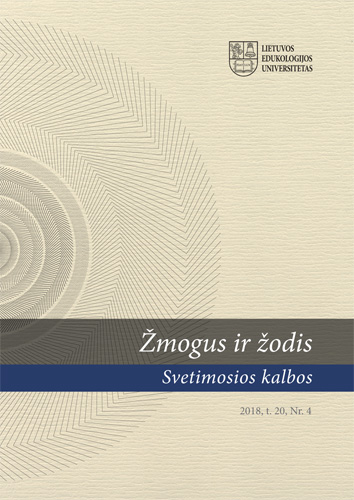Getting the Feel for English Rhythm: a Musical Approach
Getting the Feel for English Rhythm: a Musical Approach
Author(s): Giedrė Balčytytė-KurtinienėSubject(s): Music, Phonetics / Phonology
Published by: Vytauto Didžiojo Universitetas
Keywords: rhythm; rhythmic typology; stress-timing; vowel reduction; music instruction;
Summary/Abstract: The research into the perception and production of English rhythm has been a subject of argument among linguists and language educators for decades. English has traditionally been ascribed to the group of stress-timed rhythm languages as opposed to syllable-timed languages (Pike, 1945; Abercrombie, 1967; Ladefoged, 1975) and even though several scholars find this typological classification of languages contraversive (e.g. Dauer, 1987), certain reliable stress-timed acoustic cues remain relevant to EFL learners and help acquiring the natural sound of English. The particular rhythmic cues determine the alternation of weak and strong syllable sequences as well as the implication of certain aspects of connected speech. The EFL learners need to develop the feel for this specific English rhythm and educators worldwide suggest various natural input strategies and practice techniques. This particular paper argues for the implementation of music in order to develop the feel for English rhythm, since there is emerging evidence that language and music share a number of features at evolutionary, cognitive as well as sensory perceptual levels (Patel, 2003; Mithen, 2005; Jackendoff, 2009). Moreover, the two capacities of the human mind are similar in their expressive features as well as their hierarchic structure including the prosody: stress, meter and rhythm. Scholars in the field argue that EFL learners may benefit from this cross-domain influence, since the interaction of linguistic stress and musical meter enhances the perception and production of natural English rhythm (Besson et al., 2008). The particular experimental study was carried out on a cohort of 29 non-native English students of different linguistic backgrounds, who were exposed to selected sentence patterns through musically rhythmical expertise. The results suggested benefits in English speech rhythm: they demonstrated a better skill in stressing, strong / weak syllable production and recognition as well as vowel reduction.
Journal: Žmogus ir žodis
- Issue Year: 20/2018
- Issue No: 4
- Page Range: 4-11
- Page Count: 8
- Language: English

